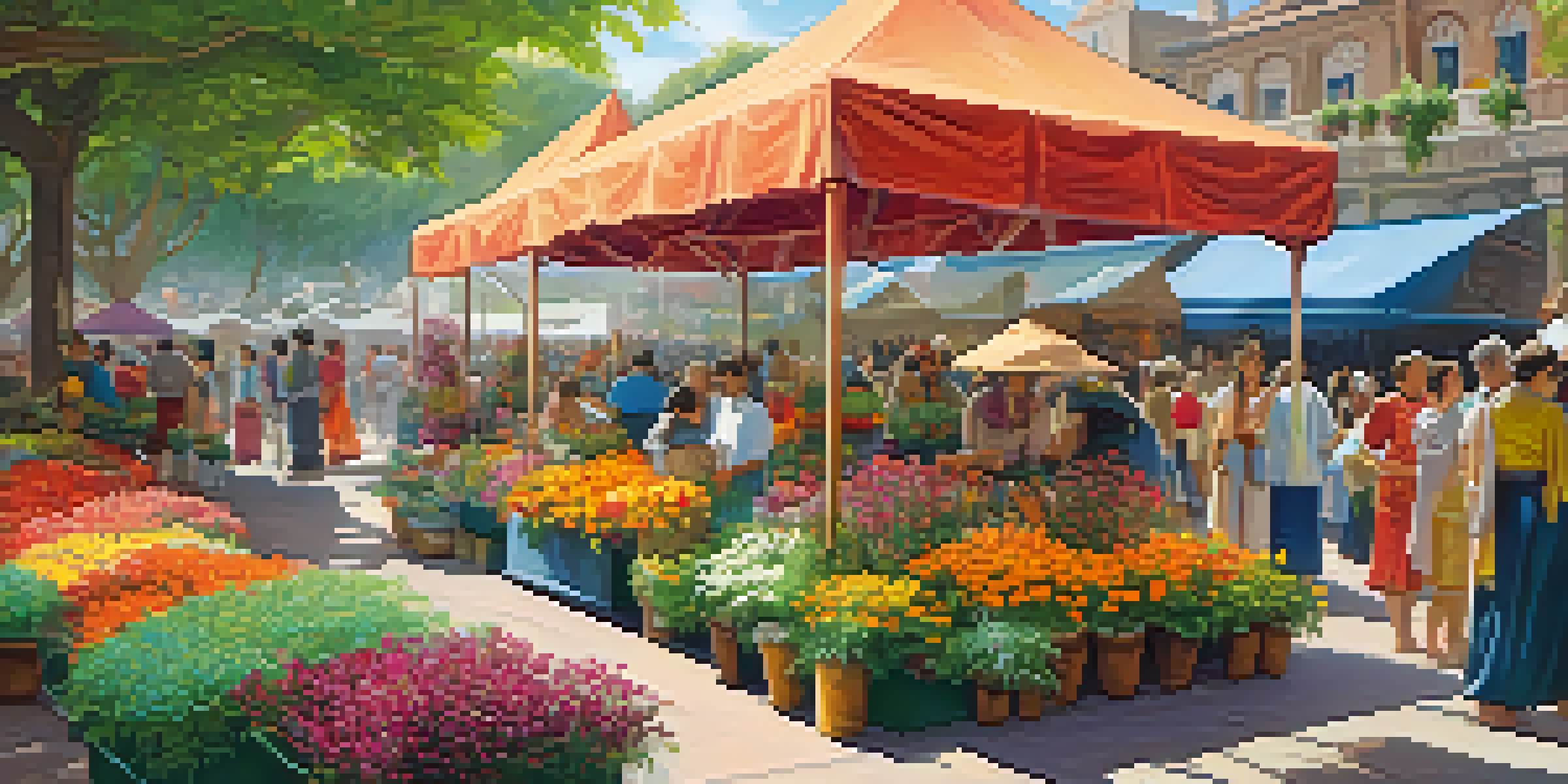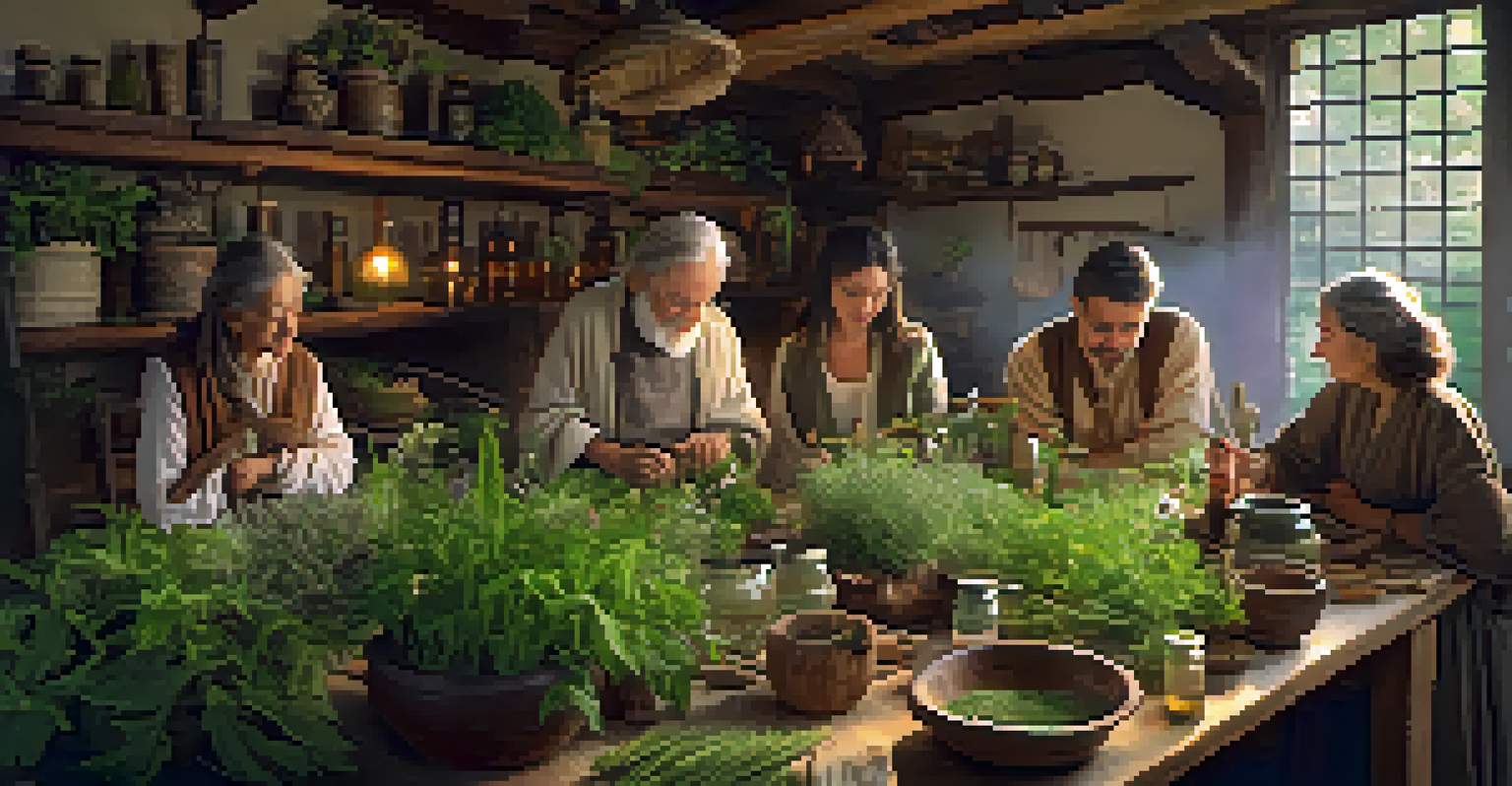The Influence of Traditional Medicine on Plant Festivals

Understanding Traditional Medicine and Its Roots
Traditional medicine encompasses the healing practices that have been passed down through generations, often rooted in cultural beliefs and local flora. This healing art emphasizes the use of natural ingredients, particularly plants, for their medicinal properties. By harmonizing with nature, traditional medicine embraces a holistic approach that considers the mind, body, and spirit.
The greatest medicine of all is to teach people how not to need it.
Many cultures have developed their unique systems of traditional medicine, reflecting their environmental conditions and available resources. For instance, Ayurveda in India utilizes a vast array of herbs and spices, while Traditional Chinese Medicine (TCM) emphasizes balance and energy flow through herbal remedies. These practices not only address physical ailments but also foster a sense of community and continuity.
As we delve deeper into the influence of traditional medicine, we can see how these practices contribute to the celebration of plant festivals, where the focus is on both healing and honoring nature. Festivals often highlight the plants that have medicinal value, creating a connection between cultural heritage and health.
The Significance of Plant Festivals in Cultural Traditions
Plant festivals serve as vibrant celebrations that honor the natural world and its resources, especially the plants that offer healing properties. These events are often marked by rituals, music, and communal gatherings, reinforcing social bonds while highlighting the importance of plants in daily life. For many communities, these festivals are a way to express gratitude for nature's bounty.

During these festivals, traditional medicine practices take center stage, showcasing the plants that have been used for healing throughout history. From herbal teas to ointments, attendees often get to see and taste the products created from these plants, enhancing their appreciation for the natural remedies. This connection fosters a greater understanding of the role plants play in health and wellness.
Traditional Medicine's Cultural Roots
Traditional medicine practices are deeply rooted in cultural beliefs and utilize local plants for holistic healing.
Moreover, plant festivals often serve as educational platforms where knowledge about traditional medicine is shared across generations. They provide an opportunity for younger generations to learn from elders about the significance of various plants, ensuring that this invaluable knowledge is preserved and passed on.
Key Plants Celebrated in Traditional Medicine Festivals
Certain plants are celebrated more than others during traditional medicine festivals due to their widespread use and effectiveness in healing. For example, herbs like chamomile, lavender, and echinacea are often highlighted for their calming and immune-boosting properties. These plants not only have medicinal benefits but also contribute to the festive atmosphere with their vibrant colors and aromas.
Nature itself is the best physician.
In addition to their healing properties, these plants often carry cultural significance, symbolizing resilience and health. For instance, in many Indigenous cultures, the use of sage for cleansing rituals is a key part of plant festivals, emphasizing purity and renewal. This dual role of plants as both healing agents and cultural symbols enriches the festival experience.
Furthermore, the celebration of these plants encourages sustainable practices, as festival-goers are often educated on how to harvest and use them responsibly. By promoting awareness about plant conservation, traditional medicine festivals play a crucial role in ensuring that these valuable resources are available for future generations.
The Role of Rituals in Plant Festivals and Healing
Rituals are an integral part of plant festivals, often serving to deepen the connection between participants and the plants being celebrated. These rituals can range from planting ceremonies to healing circles, each designed to honor the plants' contributions to health and well-being. They create a sacred space where individuals can reflect on their relationship with nature.
Participating in these rituals allows individuals to experience the healing power of plants firsthand. For example, some festivals include guided meditations or herbal workshops, where attendees learn to create their own remedies. This hands-on approach not only educates participants but also empowers them to take charge of their health using traditional methods.
Celebrating Plants at Festivals
Plant festivals highlight the importance of medicinal plants while fostering community and preserving traditional knowledge.
Moreover, rituals often evoke a sense of community and collective healing, as people come together to share their stories and experiences. These shared moments enhance the social fabric of the community, creating lasting bonds that extend beyond the festival itself, fostering a culture of support and care.
Modern Interpretations of Traditional Medicine at Festivals
In recent years, there has been a growing interest in blending traditional medicine with modern practices during plant festivals. This integration allows for a richer exploration of health and wellness, as participants can learn about both ancient remedies and contemporary approaches. For instance, workshops may combine herbal medicine with nutritional science, offering a holistic view of health.
Additionally, the revival of interest in natural remedies has led to increased participation in these festivals, with people eager to explore alternative options for their health. This modern twist attracts a diverse audience, bridging the gap between tradition and innovation. It encourages a dialogue about the efficacy of traditional practices in today's world.
By incorporating modern elements, these festivals become dynamic spaces for learning and sharing, where traditional knowledge is respected and valued. This fusion not only keeps the traditions alive but also enhances their relevance in a rapidly changing society.
The Environmental Impact of Plant Festivals
Plant festivals also play a crucial role in raising awareness about environmental sustainability and biodiversity. By celebrating plants and their medicinal qualities, these events highlight the importance of preserving natural ecosystems. Many festivals include workshops on sustainable harvesting and conservation practices, educating attendees on how to protect the plants that are vital to traditional medicine.
Moreover, these festivals often serve as platforms for advocating against the over-exploitation of certain plant species. By showcasing local flora and emphasizing sustainable practices, festival organizers encourage responsible use of resources. This focus not only safeguards the plants but also nurtures a sense of stewardship within the community.
Sustainability and Future Outlook
These festivals promote environmental sustainability and encourage the responsible use of plant resources for future generations.
As more people become aware of the environmental challenges facing our planet, plant festivals provide a refreshing reminder of the interconnectedness of health and nature. They inspire action and foster a community committed to preserving both traditional medicine and the ecosystems that support it.
The Future of Traditional Medicine and Plant Festivals
Looking ahead, the future of traditional medicine and plant festivals appears promising, as more people seek to reconnect with nature and their cultural heritage. The rising interest in holistic health and natural remedies indicates that these festivals will continue to grow in popularity. They offer a unique space where tradition meets modernity, providing valuable insights into health and wellness.
Furthermore, advancements in technology and social media can enhance the reach and impact of these festivals. Online platforms can facilitate virtual participation, allowing individuals from different corners of the world to engage with traditional practices. This expanded accessibility can help foster a global community focused on healing and sustainability.

Ultimately, the continued celebration of traditional medicine at plant festivals will depend on the collective efforts of communities to preserve their heritage while adapting to contemporary challenges. By nurturing this relationship with nature, we can ensure that the wisdom of traditional medicine continues to thrive for generations to come.